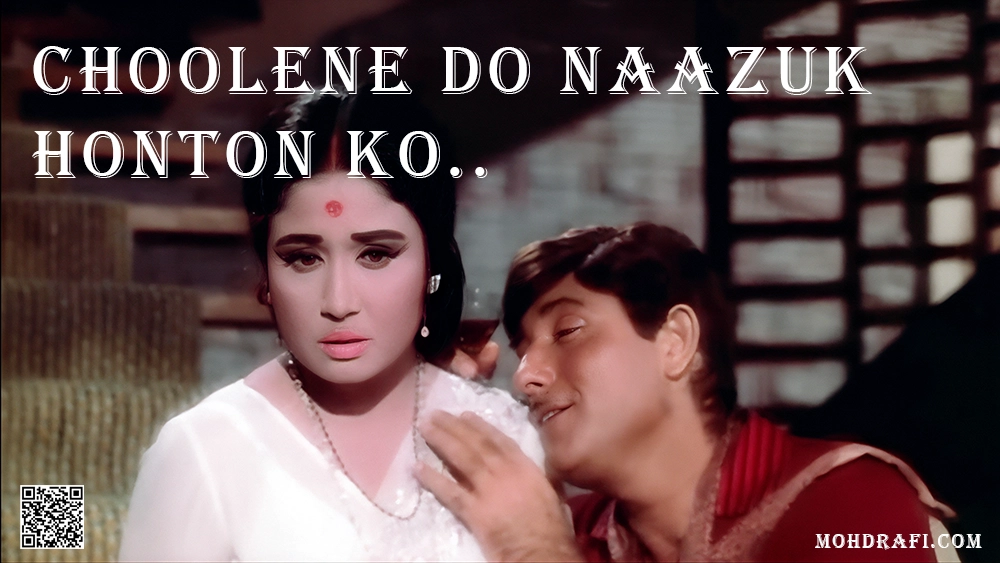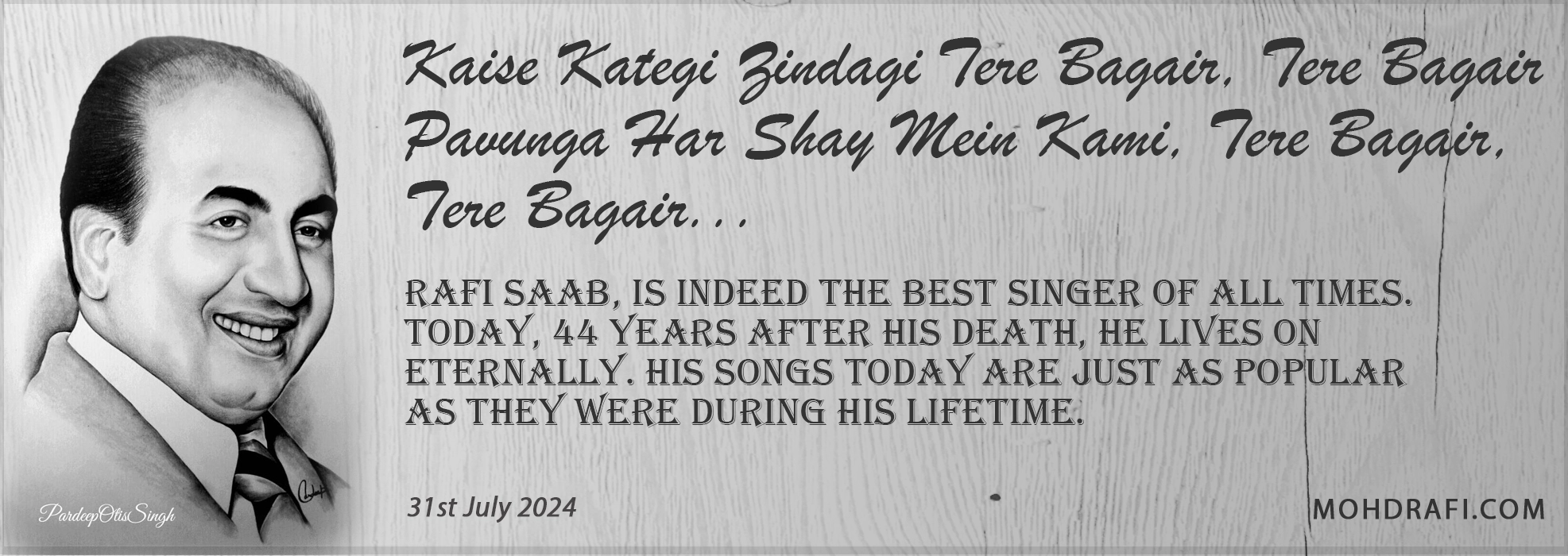Chhoo Lene Do: A Melodic Embrace of Romance and Elegance
“Chhoo Lene Do” from Kaajal is a poetic embrace of love and life, brought to life by Mohammed Rafi’s melodious voice, Sahir Ludhianvi’s profound lyrics, and Ravi’s soulful composition.

As a die-hard fan of Mohammed Rafi, there’s a particular song that holds a special place in my heart, and that song is “Chhoo Lene Do” from the 1965 film Kaajal. The moment you hear the opening notes, you’re transported into a world where romance is pure, emotions run deep, and every word lingers in your soul. The magic of this song lies not just in Mohamed Rafi Sahab’s unparalleled voice but in the synergy between the lyrics, music, and the emotions they evoke.
“Chhoo Lene Do” is not merely a song; it is a poetic masterpiece that weaves together love, respect, and longing in the most tender manner. The way Rafi Sahab caresses each word, the softness with which he delivers the lines, and the subtle nuances he brings to every note make this song an epitome of romantic expression.
Sahir Ludhianvi’s lyrics, combined with Ravi’s soothing composition, make this song a timeless classic that resonates even today. The way Rafi Sahab sings Chhoo Lene Do Naazuk Honton Ko, it’s as if he’s urging the listener to appreciate the delicate moments in life, much like one would savor the fleeting beauty of a blossoming flower.
Mohammed Rafi’s Dedication to Perfection
This is about Mohammed Rafi’s dedication to his craft. It is said that Mohammed Rafi would often rehearse his songs multiple times before the actual recording, focusing on every detail to ensure that the final output was flawless. This dedication to perfection is evident in “Chhoo Lene Do,” where every note and word is delivered with such precision that it feels effortless, though it was anything but.
Rafi Saab’s ability to embody the emotions of a song was unparalleled, and his work with Ravi and Sahir was a perfect example of how a singer, lyricist, and composer could come together to create magic. While there may not be a single, widely known anecdote about this specific song, the collective history of these artists working together is filled with instances of deep respect, hard work, and an unwavering commitment to creating music that would stand the test of time.
One notable aspect of the collaboration between Mohammed Rafi, Sahir Ludhianvi, and Ravi is the mutual respect and understanding they shared for each other’s craft. Ravi, the composer, once mentioned that he always felt confident when Rafi Sahab was the singer for his compositions. Ravi believed that Rafi had the ability to bring out the finest nuances of a song, no matter how simple or complex the composition was.
A Closer Look at the Lyrics and Emotions
Let’s delve deeper into the lyrics, written by the legendary Sahir Ludhianvi:
Chhoo Lene Do Naazuk Honton Ko,
Kuch Aur Nahin Hai, Jaam Hai Yeh,
Kudrat Ne Jo Hamko Baksha Hai,
Voh Sabse Haseen Inaam Hai Yeh.
(छू लेने दो नाज़ुक होंठों को,
कुछ और नहीं है, जाम है ये,
कुदरत ने जो हमको बक्शा है,
वह सबसे हसीन इनाम है ये।)
This opening stanza beautifully encapsulates the essence of the song. Sahir implores to touch the delicate lips, comparing them to a goblet filled with the nectar of life. The lips, symbolizing love and tenderness, are presented as nature’s most beautiful gift. The emotion here is of reverence, where love is elevated to something divine, pure, and worthy of gentle admiration. Mohamed Rafi Sahab’s voice, with its silken texture, adds an extra layer of depth, making this verse feel like a soft whisper of affection.
Sharama Ke Na Yunhi Kho Dena,
Rangeen Jawani Ki Ghadiyan,
Betaab Dhadakte Seenon Ka,
Armaan Bhara, Paigaam Hai Yeh.
(शरमा के ना यूँ ही खो देना,
रंगीन जवानी की घड़ियाँ,
बेताब धड़कते सीनों का,
अरमान भरा, पैगाम है ये।)
In this verse, the Sahir Ludhianvi speaks of not letting the vibrant moments of youth slip away due to shyness or hesitation. The pulsating hearts, filled with desires and dreams, convey a message of embracing the passions of life. The song here touches upon the fleeting nature of youth and the importance of living in the moment. Rafi Sahab’s rendition brings out the urgency and passion embedded in these lines, urging the listener to embrace life fully, without reservations.
Achhon Ko Bura Saabit Karna,
Duniya Ki Puraani Aadat Hai,
Is Mai Ko Mubaarak Cheez Samaj,
Maana Ke Bahur Badanaam Hai Yeh.
(अच्छों को बुरा साबित करना,
दुनिया की पुरानी आदत है,
इस मय को मुबारक चीज़ समझ,
माना के बहर बदनाम है ये।)
In the final stanza, Sahir Ludhianvi reflects on society’s tendency to tarnish even the purest of things. The wine here is a metaphor for love, often misunderstood and maligned by the world. Yet, he suggests that this ‘wine’ should be cherished, despite its infamous reputation. Rafi Sahab’s voice, filled with melancholy and defiance, perfectly captures the conflict between societal judgment and personal truth.
The Lyricist, Musician, and Actors: A Confluence of Talent
Sahir Ludhianvi, the man behind these profound lyrics, was known for his sharp, poignant, and often rebellious poetry. His collaboration with Mohammed Rafi produced many gems, including songs like “Chaudhvin Ka Chand Ho,” “Mere Mehboob Tujhe,” and “Aaj Is Darja Pilado.” Sahir Ludhianvi’s ability to blend romance with social commentary made his songs stand out, and “Chhoo Lene Do” is a prime example of this unique style.
Sahir Ludhianvi, known for his intense and meaningful poetry, had a reputation for being meticulous about how his lyrics were rendered. He was very particular about the pronunciation and expression of the words. There are stories that Sahir would often sit through the recording sessions to ensure that the emotion he intended was accurately captured by the singer. When it came to Rafi Sahab, Sahir had full faith that his words were in the best hands, which speaks volumes about the mutual admiration they had for each other.
Ravi, the composer, had a knack for creating melodies that perfectly complemented the mood of the lyrics. His association with Rafi Sahab led to the creation of numerous memorable tracks like “Aaraam Hai Haraam” from Apna Ghar (1960), “Baar Baar Dekho” from China Town (1962) and “Bandha Huva Ek Ek Dhaage Mein” from Rakhi (1962). Ravi’s compositions often had a simplicity that allowed Rafi Sahab’s voice to shine, as is evident in “Chhoo Lene Do.”

The actors, Rajkumar and Meena Kumari, brought the emotions of the song to life on screen. Rajkumar’s intense gaze and Meena Kumari’s soulful expressions added a visual depth to Rafi Sahab’s voice. This was not the only time these two actors shared the screen in a film that featured Rafi Sahab’s voice; their pairing in movies like “Pakeezah” and “Dil Apna Aur Preet Parai” also led to the creation of iconic musical moments.
About the Movie: Kaajal
Kaajal (1965) is a drama that revolves around themes of family honor, love, and sacrifice. The film, directed by Ram Maheshwari, is remembered not only for its gripping storyline but also for its musical score. Songs like “Chhoo Lene Do” and “Tora Mann Darpan Kehlaye” played a significant role in the film’s success, and they continue to be cherished by music lovers even today.
Film: Kaajal
Year: 1965
Singer: Mohammed Rafi
Lyrics: Sahir Ludhianvi
Music: Ravi
Actors: Rajkumar, Meena Kumari

I’ll be happy who guide me the ongoing casting voting platforms or websites that are ranking the most popular singers in the world. I want to see the ranking list and cast vote of Muhammad Rafi Sahib.